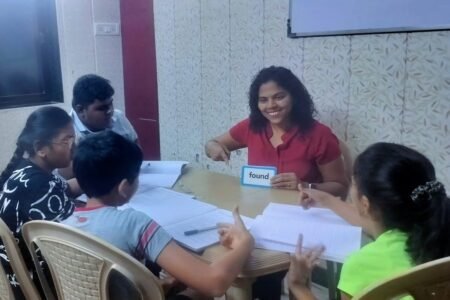“Every child deserves a classroom where they are not just seen, but understood.” In part one of our conversation, special educator Jyotsna Waghmare opened our eyes to the unique learning journeys of autistic children, shedding light on the challenges, misconceptions, and the power of inclusive education. Now, in Part 2, Jyotsna takes us further into the emotional and practical realities of autism education. From creating sensory-friendly spaces to understanding the weight of societal attitudes, she shares insights that are both inspiring and thought-provoking. Her advice for parents, honest reflections on Indian schools, and her heartfelt vision for the future of inclusion remind us that with compassion, awareness, and effort, every child can feel seen, heard, and valued. Q. 1 What role does sensory-friendly learning play in autism education? Ans: Sensory-friendly learning is crucial for teaching children with autism, as many are sensitive to bright lights, loud sounds, and strong smells, while others may not notice them at all. Regular classrooms can feel overwhelming, making it difficult for these children to focus and feel comfortable. Sensory-friendly classrooms are designed to provide a safe environment for various sensory needs, with dimmed lights, low noise levels, and quiet corners for breaks. Tools like fidget toys and noise-canceling headphones can help children stay calm and focused. Supporting a child’s sensory needs leads to better learning, behavior, communication, and social skills. In summary, sensory-friendly learning reduces stress for children with autism, helping them succeed in school and daily life. Q. 2 Advice for parents who are struggling with their child’s learning journey? Ans: To every parent who feels tired, confused, or worried about their child’s learning, please know that you are not alone. Many parents share these feelings, and it’s perfectly normal to have doubts or feel overwhelmed. You are doing your best, and that already means so much. Most importantly, you don’t have to carry this weight alone. Supporting a child with learning needs is a team effort, and it’s okay to ask for help. Reach out to teachers, therapists, and family members. Talk to others and share your concerns; there is strength in working together. Stay involved, remain curious, and ask questions. If something doesn’t make sense, don’t hesitate to speak up. Your voice matters. You know your child better than anyone; your thoughts and observations are important and valuable. Remember, learning doesn’t always come in big leaps. Celebrate the small steps: a new word, a smile, or your child sitting a little longer—these are significant achievements too. Avoid comparing your child to others. Every child is different, and your child is growing at their own pace and in their way. Above all, let your child feel loved, supported, and accepted just as they are. When a child feels safe and believed in, they are already halfway there. You are doing better than you think; your love makes all the difference. Q. 3 How do societal attitudes toward autism impact a child’s education and confidence? Ans: Society’s attitude toward autism plays a powerful role in shaping a child’s learning experience and self-esteem. When people around a child, including peers, educators, neighbors, and extended family, understand and accept autism, they create a world where the child feels seen, valued, and safe. Unfortunately, many children on the autism spectrum still face misunderstanding, judgment, or exclusion. This can manifest as bullying, social isolation, or being underestimated in the classroom. Over time, these experiences can diminish a child’s confidence and make them feel “different” in a painful, limiting way, not because of who they are, but because of how they are treated. The opposite is also true: when children are accepted, encouraged, and respected, they begin to believe in themselves. A supportive environment empowers them to take risks, try new things, and develop a love for learning. Inclusive classrooms and communities not only benefit children with autism but also teach all children that differences are natural and valuable. As educators, parents, and members of society, we all play a part in shaping inclusive attitudes. By talking openly about autism, modeling empathy, and building welcoming spaces, we help children with autism not only succeed in school but also flourish in life. Q. 4 Are Indian schools progressing in terms of autism inclusion, or is there still a long way to go? Ans. Indian schools have made significant strides in including students with autism, but there is still a long way to go for genuine, meaningful change. Improvements: Ongoing Challenges: India is moving in the right direction, but consistent efforts in teacher training and resources are essential for meaningful progress. Q. 5. Your vision for the future of autism education and acceptance? Ans: I envision a future where children with autism are embraced for who they are, not just in specialized settings but throughout society. Schools will become truly inclusive, with adaptable classrooms, child-centered teaching, and compassionate educators. Instead of fitting children into rigid systems, education will evolve to celebrate their unique abilities. In this world, parents will receive understanding and respect, with accessible early intervention and collaboration with professionals as equal partners in their child’s journey. Most importantly, I hope for a shift in mindset, viewing autism as a different way of experiencing the world. Children on the spectrum will grow up feeling proud, confident, and accepted, knowing they belong. With continued awareness, inclusion, and kindness, we can create a more accepting world, one step at a time. Jyotsna Waghmare’s words remind us that inclusion isn’t just a policy—it’s a practice of empathy, understanding, and unwavering belief in every child’s potential. As we close this conversation, we are left with a renewed sense of responsibility and hope. The journey toward autism acceptance in education is ongoing, but with voices like Jyotsna’s leading the way, that future feels not only possible but within reach. Let’s continue to listen, learn, and act—because every child deserves more than just a seat in the classroom. They deserve to be truly seen, heard, and celebrated.
April is observed globally as Autism Acceptance Month, a time not just to raise awareness but to embrace neurodiversity and challenge outdated perceptions. Speaking to Foramz during Autism Acceptance Month, Jyotsna Waghmare, special educator and multiple award-winning founder of Daksinya Academy (a school for children with special needs), has redefined how education for autistic children is approached in India. As Autism Acceptance Month unfolds, her words and work serve as a reminder that inclusion in education isn’t charity; it’s a right. In this exclusive interview, Jyotsna Waghmare shares insights on autism education, common challenges, and what true inclusion should look like in Indian schools. Q.1 How do autistic children typically experience learning differently from neurotypical children? Ans: As an educator, I have noticed that autistic children often learn differently from their neurotypical peers. They tend to be detail-oriented and may excel in subjects that align with their interests, even if their strengths aren’t always visible in traditional classroom settings. Some may struggle with language processing or writing due to sensory sensitivities, but these challenges don’t reflect their true potential. It’s essential to provide opportunities for them to showcase their knowledge in different ways. Sensory issues like sensitivity to noise or light can impact focus and comfort. A calm and structured environment with visual supports can help. Additionally, social interactions may look different for autistic students, and some may communicate in alternative ways. With flexibility and understanding, we can support their unique strengths and help them thrive. Q.2 What are some common misconceptions about autism in the education system? Ans: I often see that many educators and even doctors still hold outdated beliefs about autism, which can limit support for autistic children. A concerning trend is that parents are often advised by pediatricians to focus solely on therapy for a few years, assuming education can wait. As a result, some children begin formal education as late as 8 to 10 years old, making it harder for them to grasp foundational concepts. It’s important to recognize that therapy and education are interconnected. Learning should not be postponed; both can and should occur simultaneously Q.3 How can mainstream schools become more inclusive for autistic students? Ans: Inclusion isn’t about making autistic students fit a traditional mold; it’s about reshaping that mold to meet the needs of every learner. In Indian schools, this shift is essential. First, awareness and training are crucial. Many teachers lack exposure to neurodevelopmental conditions like autism in their training, leading to confusion between behavioral issues and neurodiverse needs. Regular in-service training programs are needed to help teachers understand autism, recognize differences, and develop effective classroom strategies. Next, schools must go beyond token inclusion. Simply admitting a child has autism isn’t sufficient. True inclusion involves dedicated special educators, visual aids, structured routines, and curriculum adjustments. Small changes, like providing extra time for tasks or quiet spaces, can significantly improve the learning experience. Large class sizes and rigid structures are challenges, but affordable solutions like peer buddy systems and visual timetables can foster inclusivity. Schools should shift from a focus on “marks” to “meaningful learning,” prioritizing skill development and emotional well-being alongside academics. Collaborations between schools and therapy centers are essential for coordinated support, and involving parents as active collaborators creates a strong support network. Ultimately, nurturing an inclusive culture through regular activities that promote empathy and respect is vital. Inclusion is a right and a hallmark of a progressive education system. Q.4 What are the biggest challenges special educators face while teaching autistic children? Ans: Teaching autistic children is a rewarding but challenging journey that requires patience and flexibility. Each child is unique; some may be verbal while others are non-verbal, and their interests and focus levels vary greatly. Special educators must adapt their teaching methods to meet these individual needs. Communication plays a vital role, especially with non-verbal children, who may rely on pictures, gestures, or specialized apps to connect. Many children also face sensory issues, where loud sounds or bright lights can lead to meltdowns. Handling these situations requires calmness and knowledge of the child. Collaboration with parents, therapists, and other educators is crucial for the child’s growth, although it can be difficult. Despite limited resources and heavy responsibilities, special educators remain committed to helping children learn and express themselves, finding great fulfillment in their work. Q.5 What are some of the most effective teaching strategies for autistic children? Ans: Teaching autistic children works best when we offer structure, clarity, and flexibility based on their strengths. Here are some of the most helpful strategies we use at Dakshinya: Step-by-step charts and flashcards help children understand tasks and transitions. Predictable routines provide safety, and preparing for changes reduces stress. Teaching is personalized, adapting to how each child learns, whether through touch, songs, play, or videos. Assistive technology, like communication apps and sensory tools, aids expression and focus. We emphasize positive behavior support, using calm responses and positive reinforcement instead of punishment to build trust. Social skills are developed through role-playing, social stories, and buddy systems. Collaboration with parents and therapists is essential, ensuring consistent support and communication, including with mainstream schools. Q.6 How do you personalize learning plans for autistic students with varying needs? Ans: Every autistic child is unique, so teaching them requires understanding their world, strengths, challenges, interests, communication style, and sensory preferences. This personalized approach begins with close observation and gathering insights from parents, therapists, and the child. Based on this information, we create an Individualized Education Plan (IEP) with clear goals tailored to the child’s learning pace, whether they need support in speech, social skills, academics, or daily life skills. Teaching strategies are adaptable, allowing for different learning styles through visuals, hands-on activities, or digital tools. We also make environmental adjustments, such as creating quiet spaces and incorporating movement breaks, to enhance comfort. Collaboration with school counselors and teachers is essential for ensuring consistent support. This joint effort has proven successful, helping many children thrive. At Dakshinya, we regularly update each child’s learning plan


